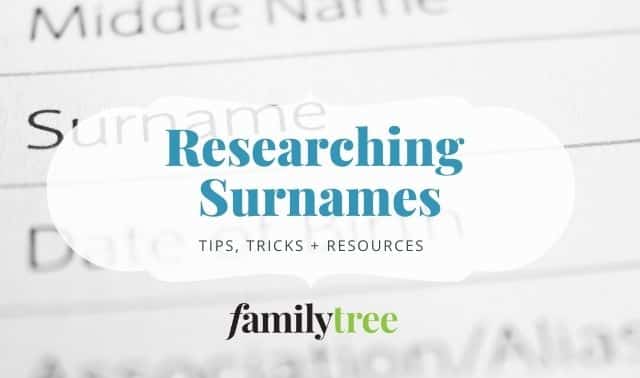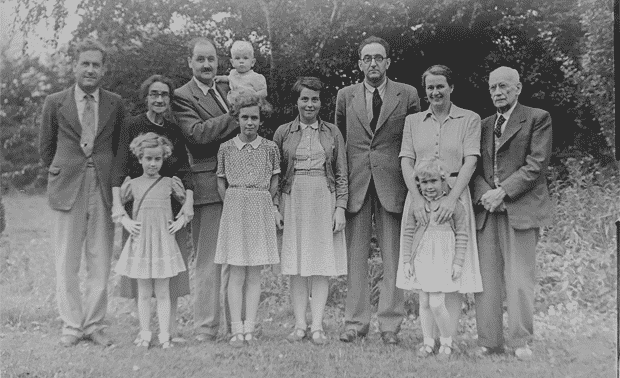Sign up for the Family Tree Newsletter! Plus, you’ll receive our 10 Essential Genealogy Research Forms PDF as a special thank you.
Get Your Free Genealogy Forms
"*" indicates required fields
Jump to:
My ancestor changed the spelling of his name. What should I do?
Which surname spelling is correct?
Why is my surname misspelled?
Follow the biology, or the surname?
Why are some surnames so popular?
How do I cite records with incorrectly transcribed names?
How do I list royal ancestors with no last name on my family tree?
Related Reads
My ancestor changed the spelling of his name. What should I do?
Q: My third-great-grandfather (1833-1897) changed the spelling of his surname from Kyes to Keyes. It doesn’t appear that anyone else in his family did the same. Should I look for a legal name change document?
A: Such spelling changes—deliberate or accidental—were common in the 1800s, when the spelling of names was much less consistent than today. (In my own family, lore has it that an ancestor added an e to a surname to make it Stowe, simply because she thought it looked fancier that way.) Even today in most states, however, you can legally change your name for any reason simply by using the new name, without any paperwork.
A court order may be required for institutions such as banks and government bodies to accept the change, and much paperwork would be generated in updating driver’s licenses, Social Security records and the like. Back in the 1800s, with much less such bureaucracy, it’s likely your ancestor simply started spelling his name differently without any paperwork. If there was a formal name change petition, the records would be found in state court.
Answer provided by David Fryxell
A version of this article appeared in the September 2015 issue of Family Tree Magazine
Which surname spelling is correct?
Q: We have a problem with different spellings of our name, Pargeon. Back to the great-grandfather it was spelled Pargin, Pargen and even DePearrygin, which we’ve been told is French. How do we tell which is correct?
A: Expect spelling variations of given names and surnames. Ancestors didn’t always write or spell their names for clerks, and clerks recorded what they heard or thought they heard.
The correct name was whatever each family member used. Thus, the question is not necessarily finding one “correct” spelling but finding the correct ancestors. Look for original records on which ancestors wrote their own names; papers of this kind are often still within the family. Look for spelling variations in indexes and records as you research. Collect copies of a variety of records that are as close as possible to the original, rather than published transcriptions and abstracts. From such records that were contemporary with the ancestors, you may find a consensus on what the family considered the name to be or how they may have pronounced it. Remember; different relatives may have used different spellings. As long as you have other matching information (right given names, times, places, relationships or other details), you can usually determine which records pertained to your family, regardless of the spelling of the surname.
Begin with yourself and prove your lineage backward, one generation at a time. When you feel you have reached the immigrant ancestor of this name, research him and his children thoroughly in US records. Let these records help you determine his birthplace. Even if the name is of French origin, the immigrant ancestor may not have come to the United States from France.
Answer provided by Emily Anne Croom
A version of this article appeared in the August 2002 issue of Family Tree Magazine
Why is my surname misspelled?
Q: I keep finding my family name spelled differently. Why does this happen and how can I make sure I’m not missing a spelling variant when I search?
A: I’ve heard many people say, “That can’t be my ancestor because we spell our name differently.” I made that mistake for many years. In my personal research, it’s turned out that Francis Johnson and Franz Janzen were exactly the same man, with the same wife and children. Beginning genealogists often disregard valid information on an ancestor simply because of the way a name is spelled.
Remember, we enjoy much more formal education than our ancestors typically did. They may not have been able to read or write English, or even to speak the language well. It’s easy to imagine how a New England town clerk could record Johnson when speaking to an older German man named Janzen, or how a census taker in the Deep South could mistakenly record Capley for the young southern belle named Kepley. National and regional dialects can also dramatically affect the way a name might be spelled phonetically. And some of our ancestors anglicized their names intentionally, while others simply preferred a new spelling. The spelling of the name doesn’t change who that person was—after all, how often has someone misspelled your name?
The secret to keeping it all straight is called Soundex. Developed to address the name-spelling problems of the 1880 census, Soundex has remained a valuable tool for family historians ever since. So in the Soundex system, Johnson, Janzen, Johanson and Jansen are the same name—they’re all J525. Sometimes a name is spelled different ways even in the same immediate family: One brother is John Smith while the other is William Smythe. Using Soundex, however, they become John and William S530.
| 1 | b p f v |
| 2 | c s k g j q x z |
| 3 | d t |
| 4 | l |
| 5 | m n |
| 6 | r |
| no code | a e h i o u y w |
A Soundex name always contains four characters, no more and no less. The first letter of the name becomes the first character of the Soundex code. The remaining three numbers are drawn from the name sequentially (see chart). Some letters in a name are ignored. When adjacent letters are from the same category, the second is ignored. An example is Schmidt: Since the number 2 represents both S and C, the C is ignored. The letters A, E, H, I, O, U, Y and W are also ignored except at the start of the name (so Adams is A352). An empty space is represented by a zero. Once the four-character limit has been reached, all remaining letters are ignored.
You can see how our example of Johnson, Johanson, Janzen and Jansen become the same Soundex name of J525. Jones becomes J520. Black is B420, as is Blake. Christopher and Christian both get coded as C623. Of course, you can’t assume that all people named Christopher are somehow related to people named Christian but, you can see quickly that Newsom, Newsome and Nuesom—all N250—are not so different that a relationship is impossible. Using Soundex also helps you consider possibilities such as Kristoph (K623) for Christopher (C623); since the letters C and K have the same numerical key of 2, it’s possible that these names are related.
Many web pages offer an online Soundex calculator, and so do many of the newer genealogy software packages. Most of the online ancestor searches offer a Soundex search option. Understanding Soundex can save you hours of frustration and keep you from missing ancestors simply because of spelling variations.
Answer provided by Carson Turner
Follow the biology, or the surname?
Q: Before she was married, my grandmother had three children (including my father) by different men. She had three more children when she married the abusive man who raised my father and gave him a surname, but not much else. I’ve met my biological grandfather, who admitted to being my father’s father, but never embraced the relationship and died with no acknowledgement of my dad as his son. Should I research that grandfather or the abusive step-grandfather? What’s the common practice—follow the biology or follow the surname?
A: It’s not uncommon to find sensitive family situations and strained relationships as you research your family history. According to Emily Anne Croom, author of the best-selling Unpuzzling Your Past, 4th edition (Genealogical Publishing Co.), the biological line is considered your “real” genealogy—but there’s no right or wrong practice for your situation. You should do what you (perhaps in consultation with family members) feel comfortable wit
What are your research goals? If you want to record family health history, determine your ethnic makeup or join a lineage society, you’d research your biological grandfather. Keep in mind you might connect with great relatives who make up for his rejection.
Some researchers go with the step familyr because that’s the closer relationship, or because information is more readily available. You also could choose to research both grandfathers—or neither, and concentrate on your grandmother’s line instead.
Either way, Croom advises clearly recording in your research notes and on your pedigree charts whether a relative belongs to your biological or step line.
Whatever line you research, be prepared for upsetting discoveries you might dig up, and be sensitive to other family members. Don’t press relatives who’re reluctant to answer questions, and avoid publicizing controversial information that involves a living person. For more on what to do when you come across a less-than-respectable ancestor, see the May 2005 Trace Your Family History, a special issue of Family Tree Magazine.
Answer provided by Diane Haddad
Why are some surnames so popular?
Q: One thing about surnames has always puzzled me: If people were often named after their occupations, why is Smith the most common name instead of Farmer? A village could usually support only one or two blacksmiths, but had dozens of farmers. Yet Farmer is not even in the top 20. And why is Brown so popular, but there are only a few Greens and Blacks? Red and blue may show up in foreign names, but there aren’t any yellows or oranges.
A: The key to surname origins is not just what was most common, but what might have distinguished one family from another. Distinguishing people, after all, was the whole purpose of naming. For example, the smith in a village would stand apart by his trade and thus that would be his “label.” Almost every other man would be farming, so it was necessary to distinguish those families by something else. Of course, in later American history, those wishing to assimilate, such as recent immigrants or former slaves, would perpetuate the trend by taking the simplest and most common American names.
In pre-colonial Britain, the name Farmer often designated a noble family, that of a landowner high-ranking enough that his tenants or servants did the manual labor. Thus, Farmer didn’t usually mean the commonplace folks.
As for colors, brown, black, white and green are the most commonplace in our lives and thus our naming. Brown may have referred to skin tone in some ancestors. Again, immigrants altering foreign names in order to assimilate, such as Braun or Braunreiter, might take Brown. Green often designated someone who lived on the old-world village green, but again would be a logical name conversion for immigrants. The other colors mentioned are less related to earth, grass, forest or crops, and thus to a family’s location.
We can speculate on the unknown origins of ancient naming practices through social history and word usage, but we may never know a single moment or motive for inventing those names. See Family Names: How Our Surnames Came to America by J. N. Hook (Collier Books, out of print) to learn more about naming patterns.
Answer provided by Katherine Scott Sturdevant
A version of this article appeared in the June 2001 issue of Family Tree Magazine.
How do I cite records with incorrectly transcribed names?
Q: My husband’s family’s Albanian surname Tseko is incorrectly transcribed in many records. How should I cite this in my family tree?
A: Transcription errors as well as outright enumeration mistakes are common with census records, and ancestors’ names can be spelled any which way in these and other sources. There’s no one “right” way to deal with this issue, and you’re certainly free to handle it however you think best in your family tree.
Our advice, though, would be to enter this record as Tseko, especially since that’s how it appears to read to you when eyeballing the original document. If your genealogy program has a field for details or notes about this entry, you could then elaborate with a note, such as “transcribed as Tucker.” It’s especially useful to keep track of this error so that you and others with whom you share your family information can locate that listing again.
Answer provided by David Fryxell
A version of this article appeared in the December 2015 issue of Family Tree Magazine.
How do I list royal ancestors with no last name on my family tree?
Q: I have members of the English royal family in my tree, but I’m stumped as to how to list them. What should I put for a king’s last name?
A: According to the official website of the British monarchy, before 1917, members of the British royal family had no surname, but only the name of the house or dynasty to which they belonged. You could use that in lieu of a last name, so Henry VIII would be Henry Tudor, for example, and James I would be James Stuart. Like surnames, these “House” names came from the father, so Queen Victoria’s eldest son, Edward VII, belonged to the House of Saxe-Coburg-Gotha (the German family name of his father, Prince Albert).
In 1917, however, George V specifically adopted Windsor not only as a dynastic name, but also as the surname of his family. The change was sparked by anti-German sentiment during World War I, with “Windsor” coming from the castle of that name. In 1952, Elizabeth II’s surname and that of her descendants was modified to Mountbatten-Windsor, adding Prince Philip’s surname.
Answer provided by David Fryxell
A version of this article appeared in the July/August 2013 issue of Family Tree Magazine.
Related Reads
FamilyTreeMagazine.com is a participant in the Amazon Associates Program, an affiliate advertising program. It provides a means for this site to earn advertising fees, by advertising and linking to Amazon and affiliated websites.










